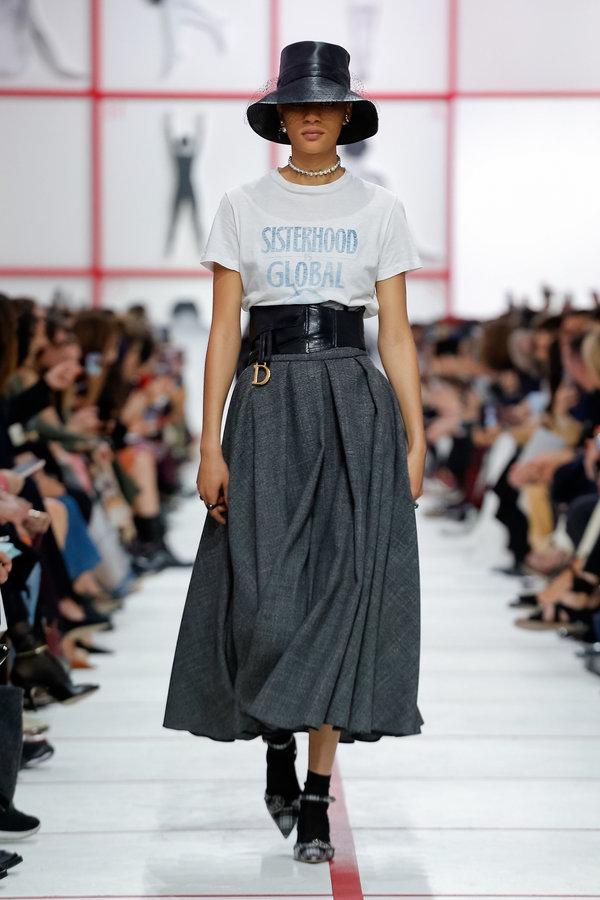PARIS — In some ways, Maria Grazia Chiuri, the artistic director of Christian Dior women’s wear, should have been made for this particular sociopolitical moment: a time when a former campaign staffer is no longer afraid to sue the president of the United States for alleged sexual misconduct, and women who kept silent for decades are finally bringing an R&B star to justice for what they say was predatory sexual behavior.
After all, Ms. Chiuri has made it her mission since arriving at the house the New Look built to put different women’s voices (literally) on her runway, from her first collection featuring a phrase from Chimamanda Ngozi Adichie to the collection she showed on Tuesday.
Dior: Fall 2019
89 Photos
View Slide Show ›

It began with the octogenarian Italian artist Tomaso Binga — a pseudonym that Bianca Menna adopted in the 1970s to “question male privilege in the art world,” according to her bio — standing at the end of the runway and reading a poem, while around her the walls of the show space were filled with photographs (her own) of a woman forming various letter shapes with her naked body.
Think of it as the ABCs of feminism. And then out came the first look: a full gray skirt and T-shirt featuring the title of a book by the poet/Ms. editor/women’s rights advocate Robin Morgan, “Sisterhood is Global.”
Which was in turn followed by a show built largely on — the playsuit.
Yup: the kind of romper worn by small children, most often associated in people’s minds with words like “cute” and “dependent” and “infant.” Is it possible to believe it is essentially a feminist garment?

Saint Laurent, fall 2019CreditValerio Mezzanotti for The New York Times
That’s a serious question.
Who decides what constitutes female power now? Who gets to define what is “appropriate” gear for the current battle of the sexes? What liberation looks like? These are entirely valid subjects for debate. Women have been shrugging off the straitjacket of the power suit for awhile now. Maybe freedom really is the ability to replace it with a onesie.
Besides, Ms. Chiuri is not the only designer positing options. At Saint Laurent, Anthony Vaccarello offered an alternative to trousers and miniskirts in the form of what looked like a fancy diaper.
Both ideas came with a fair amount of conviction and even creativity (no irony or archness here, though that might have been welcome). Yet neither was entirely convincing.
Saint Laurent: Fall 2019
100 Photos
View Slide Show ›
Ms. Chiuri’s playsuits, for example, were both smarter and more nuanced than they sound. Offered in a multitude of fabrics and styles (ruched, draped, beatnik black knit), they appeared as trompe l’oeil bustier tops in 1950s frocks paired with those long full skirts, most often fabricated from technical jacquard or taffeta, so while they looked heavy they were light enough to practically float around the body. Anchored at the waist by elasticized corsets, the skirt and belt could be discarded to reveal the activewear beneath.
Three-in-one! A modern solution to a midcentury style.
It’s not a bad idea, except for the whiff of the playground — which speaks to one of the core issues with Ms. Chiuri’s Dior, and one of the reasons her feminism sometimes feels an uncomfortable fit: well-meaning as it is, it isn’t always entirely thought through.
By contrast, the cool cropped leather pants and sculpted tartan bar jackets, inspired by the British Teddy girls of the same time period, as well as some really terrific fringed pea coats in palm tree toile de Jouy (a combination of references that was as wacky and charming as it sounds) worked very well.
As for Mr. Vaccarello’s diapers — actually sort of blouson short-shorts in black tie fabrics — these were shown with gorgeously ornate gold and crimson jackets or tuxes, all with power linebacker shoulders and spotty sheer tights and high platform stilettos or feather-topped ankle bootees. And simply proffered up as a contemporary answer to a miniskirt (albeit one that can show even more leg), built on the inspiration of the 1980s, the YSL fragrance Opium and brand muses such as Betty Catroux and Bianca Jagger.
There was also a white tuxedo suit. With pants. It looked pretty good. And long, tiered gypsy skirts in sparkling black, ditto. Which were an alternative to the tuxedo that came without pants, and suggested the benefits of those puffy shorts/diapers: no worrying about tugging down hemlines when you sit. But still: diapers.
At the end, an infinity mirror finale reflected dancing lights and a series of neon feather frocks and bright pumps stretching back and back into the past. You could just make out the outline of the clothes, which were more like abstract shapes and shades than actual garments, but the point — the way history follows us always — was impossible to miss.
Maison Margiela M/W: Fall 2019
40 Photos
View Slide Show ›
As it was at Maison Margiela, where John Galliano has been engaged in an extended effort to get to the bottom of garments and our expectations of them, gendered or otherwise.
Swapping his former signature mania for a rigorous reductivism, he broke pieces down to their simplest state — a skirt, a trench, a trouser — put them on men and women, no matter, and then shifted their purpose ever so slightly, so trousers become a cape-like dress; skirts, strapless gowns; the trench coat, a pair of long shorts.
Rendered in a limited palette of black and gray and cream, twill and flannel and herringbone, decorated sparingly with what looked like a flock of rabid silk flamingos or jeweled lace, they were all the more thought-provoking for their apparent simplicity.
There are inherited preconceptions and associations when it comes to clothing and what it means. We may be on the verge of breaking them. But it’s going to take more than a season. Just ask Amelia Bloomer.







